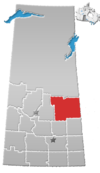Aylsham, Saskatchewan
Aylsham | |
|---|---|
S0E 0C0 | |
| Area code | 306 |
Aylsham (
History
Aylsham incorporated as a village on 4 August 1947.[1] The Aylsham post office was opened in 1921, named after Aylsham, Norfolk, England, which in turn was adopted for the community's name.[2]
Demographics
| Year | Pop. | ±% |
|---|---|---|
| 1981 | 132 | — |
| 1986 | 146 | +10.6% |
| 1991 | 104 | −28.8% |
2016 | 65 | −8.5% |
| Source: Statistics Canada via Saskatchewan Bureau of Statistics[3][4] | ||
In the 2021 Census of Population conducted by Statistics Canada, Aylsham had a population of 82 living in 38 of its 44 total private dwellings, a change of 26.2% from its 2016 population of 65. With a land area of 0.53 km2 (0.20 sq mi), it had a population density of 154.7/km2 (400.7/sq mi) in 2021.[5]
In the 2016 Census of Population, the Village of Aylsham recorded a population of 65 living in 40 of its 44 total private dwellings, a -9.2% change from its 2011 population of 71. With a land area of 0.48 km2 (0.19 sq mi), it had a population density of 135.4/km2 (350.7/sq mi) in 2016.[6]
Climate
| Climate data for Aylsham | |||||||||||||
|---|---|---|---|---|---|---|---|---|---|---|---|---|---|
| Month | Jan | Feb | Mar | Apr | May | Jun | Jul | Aug | Sep | Oct | Nov | Dec | Year |
| Record high °C (°F) | 6 (43) |
7.5 (45.5) |
17 (63) |
31.1 (88.0) |
35 (95) |
38.5 (101.3) |
34.5 (94.1) |
35.5 (95.9) |
33.3 (91.9) |
27 (81) |
17.8 (64.0) |
11 (52) |
38.5 (101.3) |
| Mean daily maximum °C (°F) | −14.3 (6.3) |
−9.5 (14.9) |
−2.4 (27.7) |
8.9 (48.0) |
17.9 (64.2) |
22 (72) |
23.9 (75.0) |
23.3 (73.9) |
16.7 (62.1) |
8.8 (47.8) |
−3.5 (25.7) |
−11.7 (10.9) |
6.7 (44.1) |
| Daily mean °C (°F) | −19.2 (−2.6) |
−14.6 (5.7) |
−7.8 (18.0) |
3.1 (37.6) |
11.1 (52.0) |
15.7 (60.3) |
17.7 (63.9) |
16.7 (62.1) |
10.7 (51.3) |
3.6 (38.5) |
−7.4 (18.7) |
−16.2 (2.8) |
1.1 (34.0) |
| Mean daily minimum °C (°F) | −24.1 (−11.4) |
−19.7 (−3.5) |
−13.2 (8.2) |
−2.7 (27.1) |
4.2 (39.6) |
9.4 (48.9) |
11.4 (52.5) |
10 (50) |
4.6 (40.3) |
−1.6 (29.1) |
−11.2 (11.8) |
−20.7 (−5.3) |
−4.5 (23.9) |
| Record low °C (°F) | −44.4 (−47.9) |
−44 (−47) |
−37 (−35) |
−29.4 (−20.9) |
−9 (16) |
−2 (28) |
1.1 (34.0) |
−2 (28) |
−7.8 (18.0) |
−22 (−8) |
−37.5 (−35.5) |
−42 (−44) |
−44.4 (−47.9) |
| Average precipitation mm (inches) | 17.6 (0.69) |
14.1 (0.56) |
19.4 (0.76) |
23.9 (0.94) |
46.2 (1.82) |
79.2 (3.12) |
80.4 (3.17) |
60.4 (2.38) |
46.1 (1.81) |
33 (1.3) |
23 (0.9) |
22.4 (0.88) |
465.6 (18.33) |
| Source: Environment Canada[7]
| |||||||||||||
Notable people
- Greg Classen Former NHL hockey player
- Karlene Faith Canadian writer, feminist, scholar, and human rights activist
See also
- List of communities in Saskatchewan
- Villages of Saskatchewan
References
- ^ "Urban Municipality Incorporations". Saskatchewan Ministry of Government Relations. Archived from the original on 15 October 2014. Retrieved 1 June 2020.
- ISBN 9780889772090. Retrieved 5 June 2020.
- ^ "Saskatchewan Census Population" (PDF). Saskatchewan Bureau of Statistics. Archived from the original (PDF) on 24 September 2015. Retrieved 31 May 2020.
- ^ "Saskatchewan Census Population". Saskatchewan Bureau of Statistics. Retrieved 31 May 2020.
- ^ "Population and dwelling counts: Canada, provinces and territories, census divisions and census subdivisions (municipalities), Saskatchewan". Statistics Canada. 9 February 2022. Retrieved 1 April 2022.
- ^ "Population and dwelling counts, for Canada, provinces and territories, and census subdivisions (municipalities), 2016 and 2011 censuses – 100% data (Saskatchewan)". Statistics Canada. 8 February 2017. Retrieved 30 May 2020.
- Environment CanadaCanadian Climate Normals 1971–2000, retrieved 23 July 2010
53°12′N 103°48′W / 53.200°N 103.800°W

